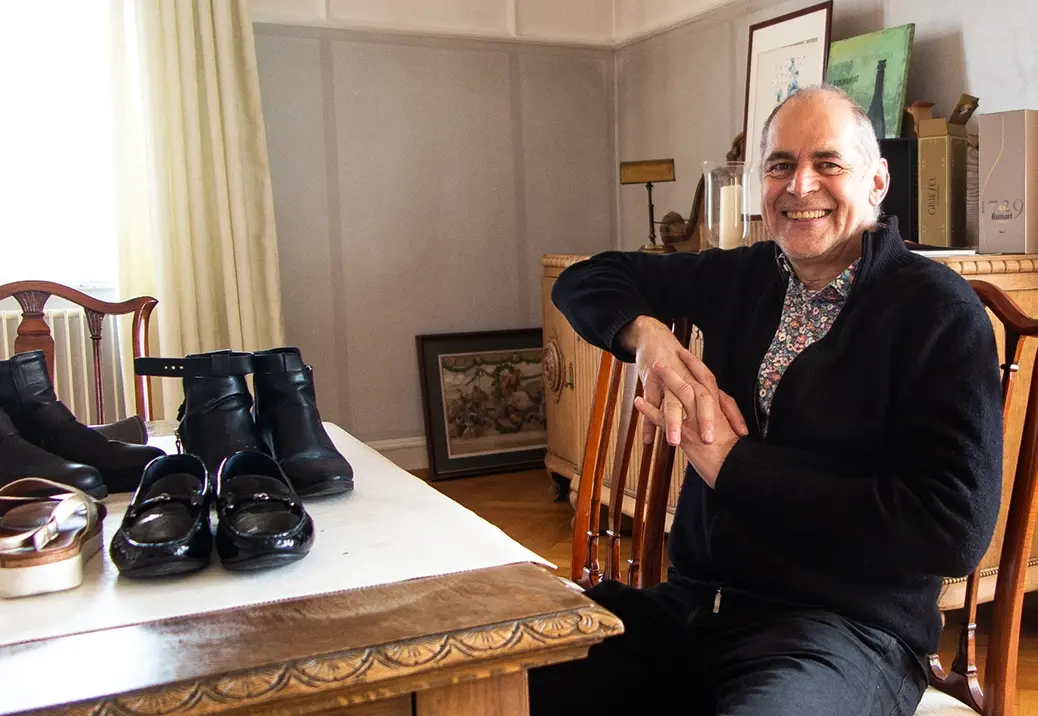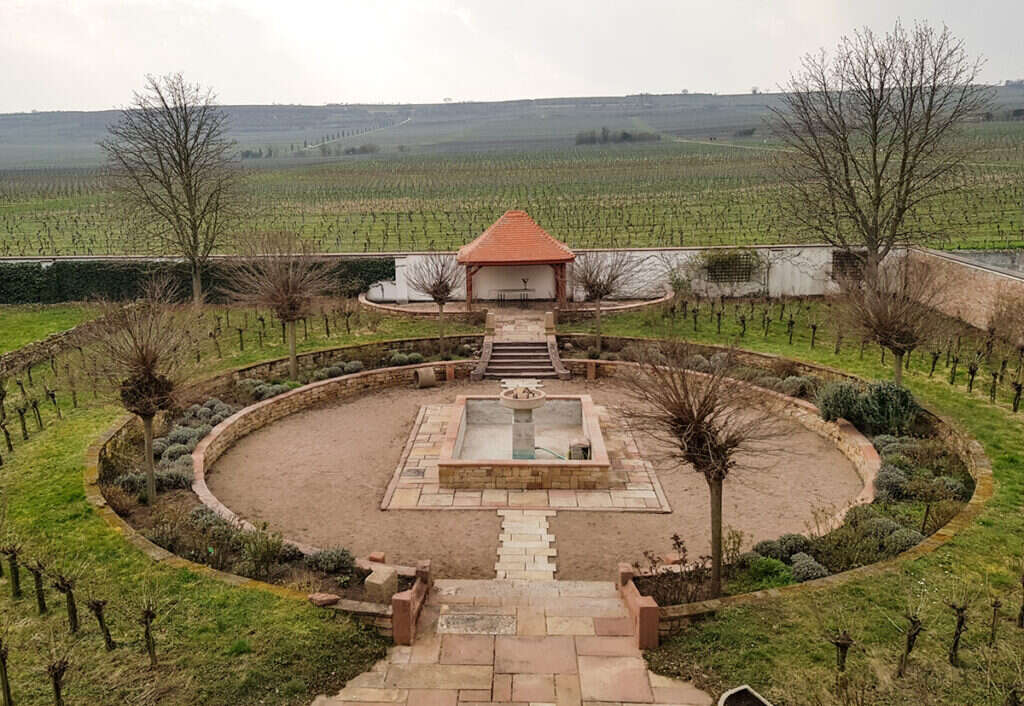
When people ask me my surname, they’re surprised when they find out that it’s Raumland, because it sounds rather like Furniture Village to them,” says Volker Raumland. By a curious coincidence, German sparkling-wine producer Sekthaus Raumland is based in Flörsheim-Dalsheim, a center of furniture manufacture, and its founder Volker Raumland is himself an avid collector of antique furniture, which he and his wife Heide-Rose display in their distinctive, yellow neo-Palladian villa cluttered with antique German cupboards, sideboards, tables, and chairs.
Located in the middle of the town, the house, dominated by a massive spiral wooden staircase, was built in 1906 by the Merkel family. The Merkel furniture business stretched to 64,600 sq ft (6,000 sq m) of industrial space and 120 employees in its heyday, having been commissioned to make furniture for the many railway stations along the Bingen-Cologne railway line. Looking for a house close to the cellar door, Volker Raumland seized the opportunity to buy it for 800,000 Deutschmarks, albeit with a 10 percent interest bank loan, when Karl-Heinz Merkel, the last of the dynasty, declared bankruptcy in 1990. Three decades on, Raumland, far from being furniture-makers, are in fact the producers of, arguably, Germany’s top sparkling wine.
From bottler, to the pope of bubbles
It was far from ordained that Volker Raumland would one day become Germany’s top Sektpapst, or “pope of bubbles,” as he is known, somewhat profanely, in Germany. While he was packed off to do a three-year apprenticeship as an industrial manager at Siemens before joining the army in 1976, his younger brother Wilfried was charged with running their parents’—Willi and Hedi’s—mixed agriculture and wine business in Bockenheim at the border of Rheinhessen and Pfalz. Volker’s stint in the army made him realize that Siemens was where neither his heart nor his future lay, but that wine just might be. On his return from the army in his mid-20s, he enrolled as a student at the Geisenheim faculty in the Rheingau.
At the time, German fizz was dominated by the “industrial” giants of Rotkäppchen and Henkell, but despite its lack of appeal to students, there was one professor who was keen to start a sparkling-wine course. After enough students were rounded up for a Sekt-Projekt, they were set the task of finding a wine from their family winery and making a sparkling wine from it. Volker rummaged around in his grandfather’s cellar and siphoned off 26 US gallons (100 liters) of a 1981 Müller-Thurgau. At the end of term, a blind tasting was organized of all the finished fizz, which included Champagne, Cava, spumante, and Prosecco. Lo! The winner was Volker’s Müller-Thurgau. This was what the Germans call the Wendepunkt—the turning point, that is, at which Volker decided to set up his own sparkling-wine business.
On a recce to Champagne, Volker’s observation of the system of mobile bottling inspired him to try something similar, and the mid-1980s proved to be a propitious moment for him. Until then, it had been possible for German producers to make sparkling wines from base wines outside Germany. From 1986, all Deutscher Sekt had to be made from German wine. At the same time, the government decided that, from 1988, producers could hold Sekt in their cellars untaxed, kickstarting the move to quality and a legal framework for premium German Sekt bA (bestimmter Anbaugebiete) and Winzersekt. Taking advantage of the new regulations, Volker bought himself a truck in 1986, installed it with mobile bottling equipment, and advertised his services in the newspapers.
The demand was more dramatic than he’d anticipated. Soon the truck was a familiar sight as it trundled through villages not just in Germany but also Austria and the Loire Valley. A couple of years later, at a Stuttgart wine festival organized by Hans-Peter Wöhrwag—a friend he’d met on the course from Weingut Wöhrwag—he was introduced to, and later married, Hans-Peter’s sister, Heide-Rose. After their purchase of the villa—which came with 4ha (10 acres) of Müller-Thurgau, Huxelrebe, Kerner, and Würzer, and a small cellar in the basement—the couple found a production facility for their sparkling wine in Mölsheim, 2.5 miles (4km) away. A large, abandoned wine cellar on four stories, three of them below ground, it was too big for their needs at first, but thanks to current annual production of 100,000 bottles, plus custom winemaking for clients, its million-bottle storage capacity is barely enough today.
In 1997, Volker received an application from a young Champenoise, Carole Lefebvre, who had recently finished her studies in Reims and was looking for experience of sparkling wine and, at the same time, to learn German. Bringing with her some of the ideas she’d taken on board in Champagne, she showed them how to press the grapes in different fractions—in particular, whole-bunch pressing the cuvée, which is retained for its good acidity, less astringency, and better aging. Lefebvre also brought with her the idea of picking for lower sugar levels and lower alcohol but not at the expense of ripeness. Intending to stay for six months, she was persuaded to stay until 2004 and remains a great friend of the family to this day.
Not aping Champagne
Thanks to Lefebvre and her introduction of ideas from Champagne, the Raumland sparkling wines became more “Champagne-like.” Today the family owns 12ha (30 acres) in Rheinhessen and Pfalz, the latter from Volker’s brother Wilfried. The original 4ha are located on the Dalsheimer Bürgel, one of the VDP Grosse Lage, and the other vineyards are in Frauenberg, Bockenheim, in Hohen-Sülzen, and in Mölsheim. The 12ha are devoted to sparkling wine, with a split of 39 percent each of Pinot Noir and Chardonnay, with the remaining 22 percent made up of Riesling, Pinot Blanc, and Meunier. Since 2002, Raumland has been certified organic, and more recently it has gone down the biodynamic route. They are not yet ready to certify as biodynamic, however, because they think the rulebook is too dogmatic and doesn’t allow the flexibility they need in the vineyard.
While the autolysis process is central to creating a more Champagne-like product for the toasty flavors that develop in the bottle during the aging process, Volker likes to stress that his aim is not to copy Champagne, because in this neck of the Rheinhessen woods, the vineyards, the soils, and the climate are all very different. The soils are mainly Terrafusca, Muschelkalk (limestone), and Algenkalk. The region is on a similar latitude to Burgundy, and rainfall is sufficient but not excessive, because they are in the rain shadow of the Donnersberg Mountains, which also protect the vineyards from hail. Nights are cool and the days are warm—a diurnal change that’s ideal for the retention of natural acidity.

At the Mölsheim production facility, Volker Raumland devised the “berry-spa” technique learned from Ca’ del Bosco in Franciacorta, adapting it to his own production methods. After finding a machine that carries out washing for salads and other delicate foods, they tried it out on the grapes and were shocked to discover that what came out was so dirty. So, today, after picking the grapes at between 75 and 80 Oechsle (10–10.75% ABV) into 33lb (15kg) crates, roughly 95 percent of the grapes are washed and then dried using this technique, with a cultured yeast to get the fermentation going, the remaining 5 percent of grapes with very ripe, thinner skins requiring greater care.
A 4-ton Willmes pneumatic press produces the first 2,050 liters from 8,800lb (4,000kg) of grapes, while the taille is used for Sekt and sold to other customers. The wines are not filtered but are cold-stabilized before tirage. All the wines undergo malolactic fermentation, and the dosage is by and large set at a maximum of 6g per liter. From a minimum aging period in bottle of 4.5 years, Raumland has recently made changes. The Tradition range (with one NV) all have 36 months’ minimum aging on the lees, though most cuvées are aged for longer. The Reserve range has more than 90 months on the lees, and the Grande Reserve wines more than 120 months. Smart, freshly designed labels bear the aging period and are now emblazoned with a plaque de muselet in the same design as the muselet itself. (The idea is from Volker’s beloved collection of muselets.)
By 2012, Volker decided the time had come to park the truck and shift the focus to the winery, where they took on a Japanese cellar master, Kazuyuki Kaise, who studied winemaking at Geisenheim (and became a cooper as well). A perfectionist, Kaise is pretty clued up on what needs to be achieved and is good at translating that vision into action. While gyropalettes do most of the donkey work of getting the yeast down into the neck of the bottle, he and the team are occasionally called on to do some hand-riddling. Apart from one Non-Vintage fizz, Raumland is a Vintage specialist. “We love the complexity of each single year, and we want to communicate that each cuvée has the influence of the vintage,” says Volker. At the same time, they started putting aside reserve wines in 2018 in order to do trials for continuity, à la NV Champagne. They even have a reserve cuvée with vintages going back to 1991, the birth year of Volker’s and Heide-Rose’s eldestr daughter Marie-Luise, which will be their 30th-anniversary flagship wine.
New-generation leaders of the sparkling pack
Since their father’s retirement in 2020, Marie-Luise, who first studied business and then enology in Montpellier, has taken over the reins of the business, while her younger sister Katharina, who graduated from Geisenheim, is in charge of cellar production. Her husband Jan (who previously worked for Wagner-Stempel, Emrich Schönleber, and Klaus-Peter Keller) takes care of the vineyards, including strategic thinking for the future, and he also makes his own Spätburgunder. “You couldn’t make a clean cut from one generation to the next even if you wanted to,” says Marie-Luise, who, in a close-knit family, works together with the whole family in the decision-making process—and that still very much includes her parents. “We are different personalities,” says Marie-Luise. “I’m more thoughtful, Katharina is more impulsive, but we all have the same vision. We all feel like winemakers.”
As evidence of the new broom, the Raumland sisters have charged Luisa Sedlmayer, an apprentice who recently joined the company, to make a fun, ancestral-method fizz from 85 percent Riesling and 15 percent Muskateller. The idea is to make not a hazy pet-nat style but something more in keeping with the Raumland ethos. The wine is made by the traditional method, starting its fermentation in stainless steel, before being bottled with 24g of residual sugar and finishing its fermentation with some nine months or longer on the lees, ending up dry, with between 5g and 7g of residual sugar per liter and 10% ABV. A preview of the wine, Ancestrale Blanc, showed a promising aromatic fizz, light on its feet, with a refreshing lemony bite to it.
Until ten years ago, Raumland was a lone wolf in the German sparkling-wine world. Traditional-method producers still make up only 2–3 percent of the market for German sparkling wines, but the Club of Traditional Sparkling Wine Producers in Germany, of which Volker Raumland is president, today numbers around 30 producers, and says Marie-Luise, “the quality is becoming better and better.” As evidence of that progress, the VDP has established a Sekt-Statut, and Raumland was accepted as the first sparkling-only winery in the VDP in January 2021.






